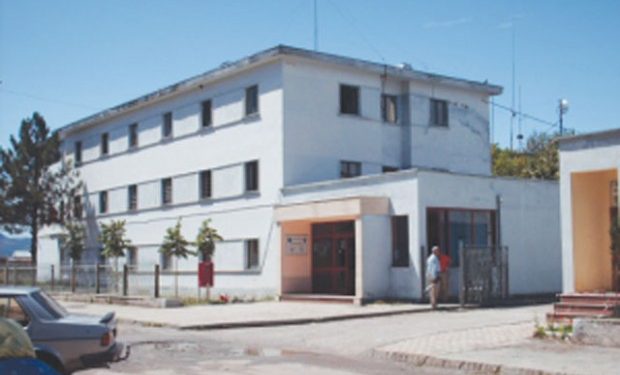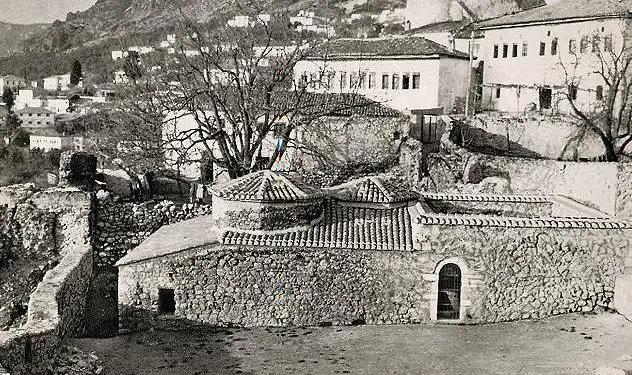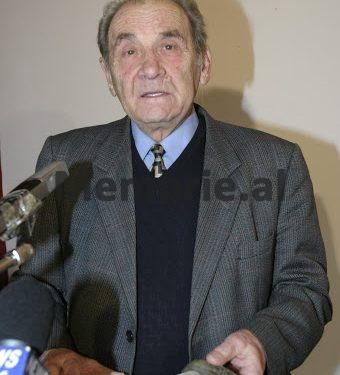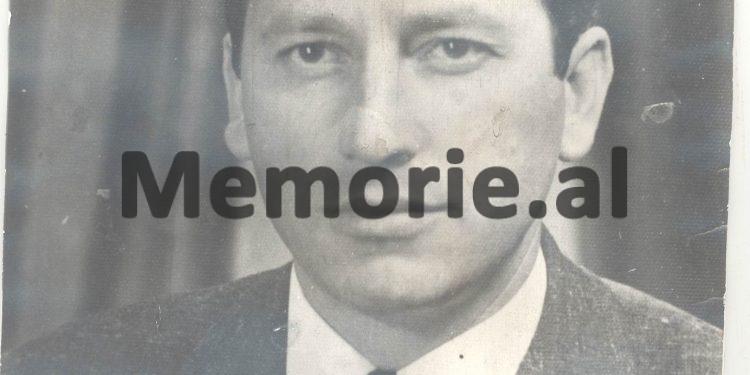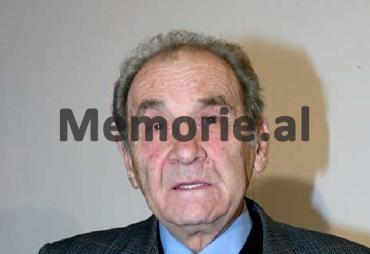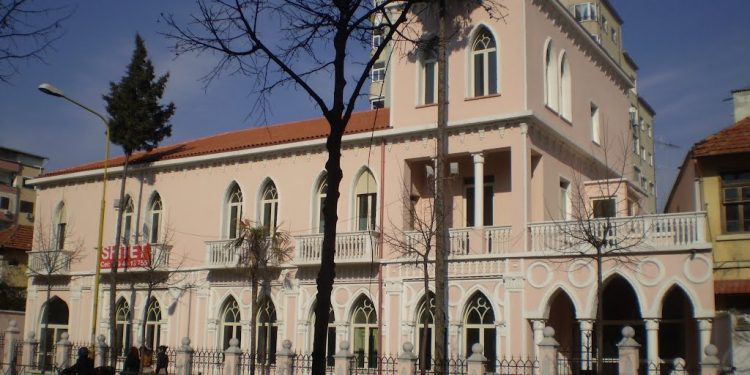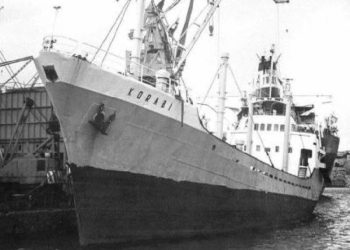Dashnor Kaloçi
Memorie.al publishes the unknown story of engineer Max Uçi, a graduate of Geology-Mining, who in 1972 started working in the quarry of the Cement Factory in Fushë-Krujë, where he became a problem for his behavior and attitudes. it contradicts the “Party line” and for that, a meeting was held to “unmask” it in front of the working collective, which was attended by the first secretary of the Party Committee of the Kruja district. The rare testimony of Sejfulla Tetës from Fushë-Kruja, for the “unmasking meeting” where he was threatened with arrest by the First Secretary of the district, after defending the rebel engineer, who was constantly by the side of the workers, which brought his sentence, transferring him to the Laç city quarry, where he lost his life in mysterious circumstances on New Year’s Eve 1980, the very day he had taken the transfer to Tirana. The magnificent funeral of Max Uçi in Tirana where seven buses with workers from Fushë-Kruja went and where the Prime Minister Mehmet Shehu also attended, as well as the visit of his friends, to the house of Professor Alfred Uçi, were in the presence of all the people who had gone there for consolation, as was Professor Servet Pëllumbi, Sejfulla Teta said: “Your brother was killed by the Security”, as well as the reaction of prof. Alfred, who was taken aback and terrified, told his friends, “This is a benefactor of our family, and he has no regrets about what he said.” How did Sejfulla Teta decide with his friend, Pirro Prifti, to throw dynamite at the Yugoslav embassy in Tirana on April 23, 1981, and how does he carry out that action without being detected by the police and the State Security ?! The subsequent arrest of Pirro Prifti and his comrades from Fush-Kruja, after the attempt to escape from the district of Kukës and Sejfulla himself, who was accused of: “together with a group of intellectuals from Kosovo, such as Shefqet, Estref and Selim Kelmendi, as well as Namik Luci, had made the plan to assassinate the main leader of the Party, Enver Hoxha, during his visit to the Skanderbeg Museum in Kruja ”?!
“After the arrest of Pirro Prifti, with whom I had dropped the bombs on the Yugoslav embassy in Tirana on April 23, 1981, I finally decided to flee Albania. So on the morning of September 29, 1982, as I was preparing to escape, I was approached by the car of the director of the Cement Factory, and I was told to go with them, “to fix an excavator.” I foresaw something and told those who asked me to: walk before I was walking after them. As soon as I got out on the national road, where Shote Galica’s headstone is located, two cars stopped at my feet. One of those who came out of them was Sadik Smaja, the crime boss of the Kruja district, who immediately threw himself on my neck, saying: ‘You remembered that life is an adventure’ ?! After they put the irons on, they put me in the car and immediately took me to the Internal Affairs Branch of Kruja, where the Deputy Chief Investigator Nexhat Selimi told me: ‘We have arrested you, because you wanted to kill the main leader of the Party with the assassinations. ‘. I was surprised by those words and instinctively asked him: ‘Who, Enver Hoxha?’? Still, without finishing his speech, at the height of his nerves, Nexhat Selimi told me: “Don’t mention his name, you got dung, you got dirt”, and he raised the rubber stick to shoot me. I couldn’t stand it and said, “That’s how Sejfulla Teta from Fushë-Kruja remembered his first arrest, who testifies exclusively to Memorie.al, confessing to all the vicissitudes of his life.” But who is Sejfulla Teta, what is his past and when did the dissatisfaction with Enver Hoxha’s communist regime arise for the first time? How did Sejfullai get to know Max Uçi, the brother of Professor Alfred Uçi, the engineer who had graduated abroad, and why did Max speak to him against the communist regime? Why did the First Secretary of the Kruja district threaten Sejfulla with the arrest at the meeting where Max Uçi was being unmasked and the mystery of the accident that took the life of the rebel engineer in the city of Laç, on New Year’s Eve 1980, exactly the day he received the transfer to Tirana ?? Why did Sejfulla Teta publicly accuse the State Security of killing Max Uçi at Alfred Uçi’s house and how did the well-known professor protect his brother’s close friend, in commemorating the six-month anniversary of his death? What were the reasons that pushed Sejfulla Tetë to plant bombs at the Yugoslav embassy in Tirana and who was Pirro Prifti, his accomplice in that action? How was Pirro Prifti arrested during the escape attempt and how did the State Security drive him into the investigation cells while awaiting the death penalty? Who were the five intellectuals from Kosovo who were accused of wanting to assassinate Enver Hoxha during his visit to the Skanderbeg Museum in Kruja? What did the investigator Nexhat Selimi ask Sejfulla and who was the provocateur who put him in the cell? What they talked about for seven hours in the cells of Kruja, on January 1, 1983, the Minister of Interior, Hekuran Isai with Sejfulla Teta and why he did not accept the accusation made against him, at a time when his “collaborators”, originating from Kosovo, they signed it during the investigation ?! Why did the trial that sentenced the four “assassins” of Enver Hoxha to death last eight days and why was it filmed with TV cameras? How was the life of Sejfulla Teta and the three members of the “group”, and the machinations of the State Security, to clash with each other in the galleries of the Qafe-Bar mine? What were the reasons and the enigmatic death in the prison of Burrel, Selim Kelmendi, one of the “assassins” of Enver Hoxha, after the letter he sent to Ramiz Alia? Where did Sejfulla Teta serve her sentence and why was she released with the last political prisoner in March 1991? For all these events and other facts of his life, we know the exclusive interview of Sejfulla Tetës, which we are publishing below starting from today’s issue.
Continued from the previous issue
Mr. Sejfulla, while Pirro Prifti and the others were in the investigation, were you afraid that you would be arrested as well?
After the arrest of Pirro Prifti, with whom I had dropped the bombs on the Yugoslav embassy in Tirana on April 23, 1981, I finally decided to flee Albania, as I waited for days for my arrest.
How did he plan to escape and with whom would he flee?
I had decided to escape alone from Luniku Librazhdit because when I was a soldier in Elbasan, I had often been there for training and I knew the place very well “.
When were you arrested and how do you remember the day you were handcuffed?
On the morning of September 29, 1982, I was on vacation, and while I was preparing to escape, I was approached by the car of the director of the Cement Factory. The person who knocked on my door informed me that they were looking for me to fix an excavator and I had to go there urgently with the car waiting for me outside the house, as I had no more than five minutes to work. At first, I thought of going there and as soon as I repaired the fault, I left for Librazhd.
Did you notice that you would be arrested?
I understood something and told those who asked me to move forward, that I was walking after them. Since I smelled something, I hid in my clothes a revolver that I always carried with me at work. As soon as I got there on the national road where Shote Galica’s headstone is located, two cars stopped at my feet. One of the people who came out of them was S. S., the crime boss of the Kruja district, who threw himself on my neck and said, “You remember that life is an adventure.” The others did not intervene, but they put the irons on me and immediately put me in the car.
Where did they take you?
They immediately sent me to the Internal Affairs Branch of Kruja, where the deputy head of the district and the party secretary, Nexhat Selimi, told me: “We have arrested you because you wanted to kill with assassinations the main leader of the party and the people “. I asked him: Who are the 12 main leaders? He replied angrily, “I am telling you the main leader of the Party and the people.” Surprised by what he was telling me, instinctively I asked him again: ‘Who, Enver Hoxha?’? Still, without finishing his speech, at the height of his nerves, Nexhat Selimi told me: “Don’t mention his name, you got dung, you got dirt”, and he raised the rubber stick to shoot me. I couldn’t stand it and said, ‘You’re a dirty man, despite that.’ From that moment on, until I was mentioned after a few hours, I can’t remember anything, because I was unconscious from the beatings that made me with rubber truncheons.
When you were mentioned, did they communicate the indictment?
Yes, Nexhat Selimi told me: “You, together with another group that we have arrested, wanted to kill the main leaders of the Party and in addition, you have put dynamite in Mamurras and the Yugoslav embassy, but we do not need these now… We are sorry for the assassination attempt that you wanted to make to the main leader of the Party when he would come to visit the Skanderbeg Museum in Kruja. You planned to throw grenades during the rally when he met with the people and if you could not do that, then Selim Kelmendi would come out, in Krasta of Kruja and would carry out with a pistol. assassination. Namik Luci in Laç, Shefqet Kelmendi in Lezha, and Estref Kelmendi in Shkodra would be the reserve option to commit this criminal act if you could not. We know everything, so don’t try to hide anything. ” When he finished, I said, ‘What if you know why you’re asking me?’ He demanded that I admit it and tortured me constantly until I fainted. The food the family brought me was given to others and told my people that I did not need food.
How long did the torture against you last?
For three months in a row, the torture against me did not stop. They only interrogated me at night, and after handcuffing my hands behind my back, Nexhat Selimi trampled my handcuffs on my legs, and from the weight of his body, he broke my left hand, which I still have today. Torture against me ceased only with the order of the Minister of Interior, Hekuran Isa when he came to meet me in the cells of Kruja.
When did Hekuran Isai come and how do you remember meeting him?
It was January 1, 1983, when a person came to my cell in Kruja and first asked me if I knew him. When I told him: I only knew the excavator and my tales and nothing else, he took off his hat and said it was Interior Minister Hekuran Isai. Then I told him that I got it for one of the General Prosecutions in Tirana. After the presentation, he told me: “I come directly by order of the main leader of the Party and you have a free hand to tell us who pushed you to kill our leader. “Tell us you will have favors and we will help you have a bunch of squid at home.” After his words, I responded by saying: I threw the bomb at the Yugoslav embassy out of hatred, but I had nothing to do with Enver Hoxha. He went on to say: “Leave the bomb at the Yugoslav embassy and Mamurras’ mines because we don’t need them. We closed the bomb, the newspaper gave it, and if you want, we can show you the newspaper “Zeri Popullit”, but tell us who pushed you to kill the leader. I did not accept in any way that I had made plans for the assassination of Enver Hoxha, because even though I did not want power, that thing had never crossed my mind. Likewise, one of the reasons I did not accept that charge was that the safe bullet was waiting for him and that God could not save you.
How many hours did Minister Hekuran Isai stay with you in the cell and who accompanied him?
Hekurani stayed in my cell for seven hours, asking me various questions. In addition to his officer, S. D., of the Kruja Police, who is currently living in Fushë-Krujë, was waiting for him in the corridor.
Have they confronted Pirro Prifti and the four people originally from Kosovo who were arrested in front of you?
They confronted me after seven months, bringing me one-fifth to one in my cell, but with their mouths shut so that we would not signal to each other. Nexhati said to them: Do you know this, and when they played the head, Nexhati said to me, “We wanted so much, did you see the evidence we have?” After them, they only brought me Pirro Prifti again and asked him if he knew me. The second time, Pirro said that we had both dropped bombs on the embassy and that we had spoken out against the state. I replied: If you have dropped bombs and spoken out against the state, give an account of yourself, for I know nothing. They also confronted Sefedin Pula, who told them that he knew me as a regular person and that he had never given me dynamite. During the investigation, a provocateur named Agron Çarçani entered my cell and introduced himself to me under a different name. He provoked me by saying: we wanted to blow up the Gjole Bridge, the Milot Bridge, and the like. I didn’t eat them and after two weeks, I found a brick in the bathroom and hit it on the head to kill it. After that, Nexhat Selimi came and took him urgently to the Prison Hospital in Tirana, and me to Koci Xoxa’s dungeons at Region no. 3. As I later learned in the camps, that negative man was a close cousin of Adil Çarçan and an ordinary thief who had spent his whole life in prison.
But when they took you to Tirana, who did the investigation, and did they continue to torture you?
Even there, in the dungeons of Koci Xoxa in Tirana, I again had Nexhat Selimi and Gavrosh Andoni as investigators. Gavroshi treated me very well and never touched me with his hand, while Nexhat Selimi started the old avaz again, torturing me barbarically. Nexhat constantly came to the cell alone at three o’clock in the morning and started from the dajak. As a result of the torture I was subjected to, I went on several hunger strikes, one of which lasted 21 days until I was bled. While I was being treated at the Prison Hospital, Nexhat Selimi sent the police to pick me up, but the doctor, Meri Gjinushi, did not allow them, saying: “I do not need to be an enemy, I do my job as a doctor. I will heal him once, then if you want, eat him alive. ” After her insistence, they left and she healed me by throwing me nine bottles of blood. I was hospitalized three times after a hunger strike knocked me to the ground.
But after Hekuran Isa, another high-ranking official, did anyone else come to his cell?
When I was in the cells of Tirana, the Deputy Prosecutor General came to me and I complained to him about Nexhat Selimi, telling him that he was stripping me alive.
During the interrogation, were they allowed to visit their family?
Not only were they not allowed, but for more than two years, my family knew nothing about where I was. Twice in Fushë-Krujë the word was spread that I had died.
How long did you stay with the investigator?
I stayed with the investigator for 27 months, torturing me with the most horrible things. Back in November 1984, investigator Gavrosh Andoni came to my cell and brought me a large bundle of 83 pages printed on a typewriter, ordering me to read them, as it was my indictment. I confused them because they were not connected, and he said, “Oh, what have you done to us?” He sat cross-legged with me in the cell, fixing them. When he left, he told me, “Don’t worry, they won’t shoot you, because you didn’t kill anyone.”
When did you go to court and who was with you at the dock?
After 27 months of horrific investigations in the cells of Kruja and Tirana, on November 24, 1984, we were brought to trial, which took place in the Court of Tirana, with prosecutor Loni Moskon and the presiding judge, Tamara Malaj from Tropoja. The trial against us continued for eight days, morning and afternoon, and in the dock of the accused, besides me, were also Selim Kelmendi, Estref Kelmendi, Shefqet Kelmendi, Namik Luca and Pirro Prifti. The accusation against all of us was: “Agent group, which had acted to violently overthrow the people’s power and assassinate the main leader of the Party”, as both the investigator and the court, as a rule, did not mention the name. of Enver Hoxha. The trial was held behind closed doors and was attended by almost all district judges and prosecutors, as well as a large number of military officials from the Interior Ministry who had filled almost the entire hall. The courtroom was illuminated with several large spotlights, as from the first session to the last, they were filmed with two Albanian television cameras and their tapes, as we learned later, were sent to Enver Hoxha to see them. During the lunch break between the two sessions, we were each taken to a separate car and sent to Koci Xoxa’s cell, accompanied by numerous police cars, front and back. That was done to make a fuss and to make it clear that we were a very dangerous group, just as the State Security had opened its mouth to the people.
Did you accept the accusation?
None of us admitted the charge and we all denounced the torture that was inflicted on us during the investigation, saying that the investigative minutes were signed by us as a result of the inhuman torture inflicted on us. At trial, I only admitted to dropping the bomb on Mamurras at the Yugoslav embassy, while Pirro Prifti was deeply depressed by torture and electroshock, and he could not control himself when he spoke. Seeing the difficult situation, Shefqet Kelmendi, got up and said that he was to blame for everything that had happened, adding that we were innocent and he had taken us by the neck. He took all the blame on us, to make it easier for us, when in fact I had never known that man. During the trial, Sefedin Pula was also brought as a witness, who was arrested with another group, who defended us, saying that they had brought him there in vain, as he did not know any of us.
At the end of the trial, what decisions were made?
At the request of the prosecutor’s claim, the trial panel handed down four death sentences: for me, Selim Kelmendi, Pirro Prifti, and Shefqet Kelmendi, and for the others 25 years in prison. But after Shefqet took all the blame for easing the rest of us, the court left him alone with death, while the rest of us were sentenced to 25 years in prison. Only Sefedin Pula was sentenced to 14 years in prison on charges of giving us dynamite for the assassinations. But after a month, while we were in the cauldron of Tirana, waiting to be distributed to us in the camps, we learned that Shefqet Kelmendi was also spared his life by the decree of the People’s Assembly.
In your last word, what did you ask for?
None of us asked for mercy, only justice.
During the court hearings, were your families allowed to attend?
Not only were they not allowed, but our families didn’t even know anything about our fate. After my sentence, my family (wife and five children) was interned in Malecaj, Lezha, where the families of Todi Lubonja and Fadil Paçrami were. For the next four years, they lived in extremely inhumane living conditions, looking for fields for some potato grains, as they had no bread to eat. Likewise, they had no clothes to wear, only those who forgave you a cloth.
Where did you suffer the punishment?
I suffered the punishment in Qafë-Bari and Burrel, but I wanted to say that after the decision was made, we were all sent to the Qafë-Bar camp, leaving us all together in a gallery. That thing was done on purpose so that we could get into trouble and kill each other, but after they saw that we were doing very well and we had no conflict, they dispersed us. While serving his sentence, Sefedin Pula and Selim Kelmendi died in prison. Sefedini died accidentally in Qafë-Bari, being caught by a wagon while helping some of his friends. Everyone felt sorry for him because he was a very good man. Meanwhile, Selim Kelmendi, the language and literature teacher of the Fushë-Krujë gymnasium, died in Burrel prison, a few days after he was returned from the prison hospital in Tirana. His death remained mysterious and suspicious, as he had written a letter to Ramiz Alia at the time stating that he had left nothing unsaid.
When were you released from prison and how do you remember the first days of freedom?
I was released from prison on February 26, 1991, by Burrell, the last political prisoner to be released from communist prisons. When I went home, the little girl, whom I had left for six months, said to the woman, “Oh, Mom, why didn’t this man leave the house, what does he want here?”
After the ’90s, did you meet any of those people who accused you and were unjustly convicted?
To be honest, I searched for investigator Nexhat Selimi all the way to Greece, but I did not find him. I did not work with others because they only did their job./Memorie.al




